|
Amazing Athletic Feats
Author:
Stan Reents, PharmD
Original Posting:
12/27/2010 09:40 AM
Last Revision: 02/09/2021 08:18 AM
Before you assume that an athletic goal is impossible, browse these stories of people who have done some amazing physical achievements..... 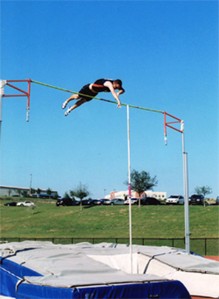
POLE VAULTING I've always felt that the pole vault is the most spectacular athletic event humans perform. The rings in gymnastics is also pretty darn impressive, but, pole vaulting gets the top ranking on my list. (FULL DISCLOSURE: I was a pole vaulter in high school, but, of course, I'm not biased!....) When I was in high school, pole vaulting was only for boys. Today, collegiate women are vaulting 15-ft regularly. The athlete in this photo is clearing roughly 15.5 feet. That's a really impressive vault, but it's nowhere near the current world record: 20-ft, 3.25 inches (6.18 meters) by Swedish vaulter Armand Duplantis. He did it on February 15, 2020 at an indoor meet. Between 1984 and 1994, Ukranian legend Sergey Bubka was the king of the pole vault. He set the world record 17 times. He was the first to clear 20-ft (on August 5, 1991). He posted his final record -- 20 ft, 1.5 inches -- on July 31, 1994 and that stood for 20 years! RIDE A BICYCLE ACROSS THE CONTINENTAL US! Quite a few people have ridden a bicycle across the continental US. In fact, several AthleteInMe.com® fans have done it and are featured in our GALLERY. Typically, they will ride from the west coast to the east coast and cover a little over 3000 miles. That's definitely a phenomenal achievement. But, during the summer of 2018, Paul Stankiewicz (Rye, NH) (age 57) rode 5000 miles! On June 13th, he rented a car and drove from New Hampshire to Eureka, California, where he started his ride. From the redwood forests of northern California, he rode to Yellowstone National Park, then, down into Missouri, and then headed back towards the northeast. He made it to Wallis Sands Beach near his home in Rye, NH, on October 17th. And he towed his dog Mona behind him in a trailer the entire way! Here's a brief story about him in Bicycling magazine. ULTRAMARATHON RUNNING For those who don't know, a marathon is 26.2 miles. Completing a marathon is a very impressive athletic achievement. But, that pales in comparison to what these people have done: Pam Reed (Tucson, AZ) Pam Reed is the race director for the Tucson Marathon. In 2002, she was the first woman to become the overall winner of the brutal 135-mile Badwater Ultramarathon. In 2005, she became the first person to complete a 300-mile run without sleep, beating legendary Dean Karnazes (see below) to that milestone. She completed the distance in 79 hours and 59 minutes. (source: Runner's World magazine, Feb. 2006). In May 2009, she established the record for American women in 6-day ultramarathons during the "Self-Transcendence Race" in Queens, NY by running 490 miles. Istvan Sipos (Hungary) Istvan Sipos ran a total of 12,526 miles over a span of 263 days, taking breaks to sleep and eat. This appears to be the longest "continuous" run ever recorded (source: Runner's World magazine, May 2004). Yiannis Kouros (Greece) During the inaugural run of The Spartathlon in Greece in 1983, an unknown young Greek man in his first ultramarathon demolished a world-class international field by winning in over 3 hours ahead of the next closest finisher. In the decade and a half since then, Yiannis Kouros went on to rewrite the world record books at every ultra event from 100 miles through 1,000 miles. Almost everyone came back from Greece suspecting that he had cheated. Half a year later, Edgar Patterman organized a 3-day, 200-mile stage race along the Danube in Austria. He specifically invited Kouros in order to test him. Some of the same international stars were in attendance (such as Dusan Mravlje of Yugoslavia, the favorite). With race officials and spectators watching virtually every step of the way, Kouros took off, left the field behind early, and even beat some of the official crews to the pre-set aid stations, averaging sub-7 minute miles for the first two days. Then, on the third day, he took it easy and ran the final stage with Mravlje. Three months later Kouros came to New York City to face an even more stellar field in the New York Transcendence 6-day race. That's where he ran 635 miles to bridge the century-old gap between modern and 19th century 6-day performers by breaking George Littlewood's all-time best of 623 miles. In that race Kouros broke 12 hours for the first 100 miles, ran about 165 miles for the first 24 hours, broke the 48 hour world record, hitting 266 miles at that point, and then just kept going. An indication of his long distance speed, Kouros' 24-hour track world record is 188-plus miles, which is about 7:40 per mile. CROSS-COUNTRY RUNS Riding a bicycle across the continental US is definitely impressive. But, what about running from one coast to the other? As I researched this article, I was stunned to find out that quite a few people have already done this, going back as far as 1909. A detailed table of all finishers is provided at www.USAcrossers.com. Several athletes are summarized below: • Paul Staso (Missoula, MT): In 2006, Paul ran from the Oregon coast to the east coast in Delaware. He covered 3260 miles in 108 days. That's 30.2 miles per day, and, represents more running than Dean Karnazes' 50/50/50 accomplishment (see below). Paul's main purpose was to fulfill a promise he made to his wife's PE students. He also wanted to increase awareness in kids about the importance of health and fitness. To read about Paul, see: www.PaulStaso.com. • John Wallace III (Ishpeming, MI): Starting on the Pacific coast of Washington September 26, 2004, Wallace (age 28) ran 3800+ miles across America, finishing at Tybee Island, GA on January 29, 2005. Details of his run can be found at: www.SeeJohnRun.com. • Scott Jenkins and Rhys Jenkins (UK): Scott and Rhys are brothers. They once ran from Boston to Austin for charity. They covered the 2000 miles in 75 days. They only rested on 4 of those days and 2 of those were due to food poisoning. Then, in 2012, they teamed up with 6 others to run the entire circumference of Wales: 750 miles in 8 days. DEAN KARNAZES: ULTRAMARATHON MAN Dean Karnazes (Inglewood, CA) has completed some absolutely mind-boggling distance runs over his lifetime. His running achievements began when he was a kid. One notable endurance run was a fundraiser where he ran laps on a track as a high school freshman. While his teammates averaged about 10-15 laps, Karnazes ran 105. 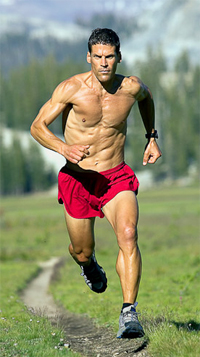 He took a hiatus from running for 15 years. Then, in 1992 on his 30th birthday, he ran 30 miles nonstop. An early goal he set for himself was to run for 24 hours straight. In 2004, Karnazes won the Badwater Ultramarathon. He then set his sights on becoming the first person to run 300 miles nonstop, but Pam Reed beat him to that title. So, he upped the ante: In October 2005, Karnazes ran 350 miles in northern California. It took him 80 hrs and 44 min, an average pace of 13 minutes per mile. (No, he did not stop to sleep.) He took a hiatus from running for 15 years. Then, in 1992 on his 30th birthday, he ran 30 miles nonstop. An early goal he set for himself was to run for 24 hours straight. In 2004, Karnazes won the Badwater Ultramarathon. He then set his sights on becoming the first person to run 300 miles nonstop, but Pam Reed beat him to that title. So, he upped the ante: In October 2005, Karnazes ran 350 miles in northern California. It took him 80 hrs and 44 min, an average pace of 13 minutes per mile. (No, he did not stop to sleep.)
In 2006, Karnazes ran 50 marathons in 50 days. And to make it even more challenging, each run was in a different state! The final one was the New York City Marathon, which he finished in a hair over 3 hours flat. Then, just for fun, after that he ran back to St. Louis where his 50/50/50 quest began. Yes, that's correct: he ran from New York City to St. Louis, MO, almost 1300 miles! But wait, there's more. Karnazes has also: - hiked the Grand Canyon rim-to-rim (at age 11!)
- swum across San Francisco Bay
- climbed Half Dome in Yosemite
- mountain-biked for 24 hours straight
- surfed the giant waves off the coast of Hawaii
(what brand of breakfast cereal does this dude eat?!!....) Read more about Dean Karnazes at: www.UltraMarathonMan.com. OLDER ATHLETES WHO HAVE DONE AMAZING THINGS And don't underestimate older athletes: Diana Nyad: Unyielding Pursuit of a Swimming Goal If you were making a list of athletes who demonstrate supreme levels of determination, swimmer Diana Nyad (New York City, NY) would have to be near the top of that list: • Cuba-to-Key West, 1st Attempt (1978): In 1978, Diana Nyad (age 28) set out to swim from Cuba to Key West, Florida. That's 103 miles. But, there were strong winds and heavy waves. After 41 hrs and 49 minutes, her handlers informed her that she was so far off course that completing the swim would be impossible. She was devastated, exhausted, and dehydrated. She didn't give up. In 1979, on her 30th birthday, she swam from Bimini in the Bahamas to Jupiter, FL. That's 102.5 miles. Then, for the following 30 years, she didn't swim at all. "I was so burned out. You couldn't pay me to take one more stroke," Nyad said. 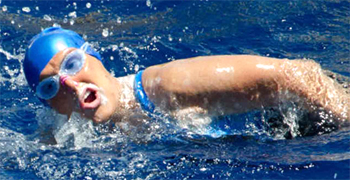 But, when she turned 60, she decided to tackle the Cuba-to-Key West challenge again. She began training. In January 2010, she swam around the island of Mazatlan (Mexico). On July 10, 2010, she attempted to swim from a boat 40 miles to the beaches at Key West, Florida. After 24 hours, she had covered 30 of the 40 miles and climbed back into the boat. She was tired and dehydrated but felt that she could complete her goal to swim from Cuba to Key West. • Cuba-to-Key West, 2nd Attempt (2011): On Sunday evening August 7, 2011, 61-yr old Diana Nyad jumped into the waters of the Florida Straits to make her 2nd attempt to swim from Cuba to Key West. Unfortunately, after 29 hours, and battling ocean swells, shoulder pain, and even an asthmatic attack, she was forced to quit. • Cuba-to-Key West, 3rd Attempt (2011): A little more than a month later, she made a 3rd attempt. She was now 62 years old. On Friday evening September 23, 2011, she dove in at Havana's Hemingway Marina. After roughly 24 hours, she got stung in the face by jellyfish. This required medical treatment, but she pressed on. After a total of 40 hours of swimming and over 100,000 strokes, she finally gave up. • Cuba-to-Key West, 4th Attempt (2012): On August 18, 2012, Nyad tried again. This would be her 4th attempt. She swam for a total of 51 hours but again had to give up due to jellyfish stings and a lightning storm. • Cuba-to-Key West, 5th Attempt (2013): On Saturday August 31, 2013, at 8:59AM, Diana, now age 64, dove into the waters off of Cuba to try again. This time, she wore a special face mask to prevent jellyfish stings. The conditions were ideal. After 53 hours, she arrived at Key West. It was Monday September 2, 2013, about 2PM. I can't decide what is the most impressive aspect of this athletic feat: the sheer distance, her persistence despite failing 4 times, or the fact that she is 64 years old! Unbelievable. If you're in awe of Diana Nyad's swimming accomplishments, read about Susie Maroney below... 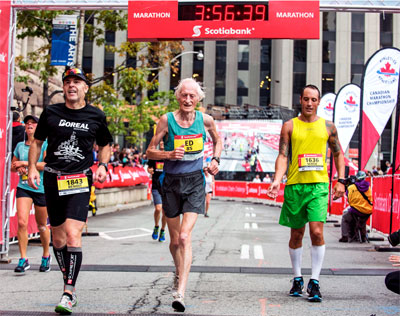 Ed Whitlock: He's How Old?!! Ed Whitlock (Toronto, Canada) ran a marathon in under 4 hours...when he was 85 years old! Yes, that's correct. In October 2016, he ran the Toronto Waterfront Marathon in a time of 3 hours 56 minutes 33 seconds. Here's a photo of him several seconds after crossing the finish line: At age 73, he ran that same marathon in an even more astounding 2 hours 54 minutes 48 seconds. He is the only person older than 70 to have run a marathon in under 3 hours. ATHLETES WHO HAVE OVERCOME MAJOR OBSTACLES Susie Maroney: A Challenged Swimmer At age 17, Susie Maroney (Australia) swam the English Channel....two laps, no less! (England to France and back to England). It took her 17 hours and 14 minutes. In May 1997, at age 22, she became the first person to swim from Cuba to the US. One year later, she set the longest distance ever swum without flippers in open sea: from Mexico to Cuba. The distance was 122 miles and took 38 hrs and 33 minutes. And now for the astonishing part: Susie Maroney has cerebral palsy! Christi Bruchok and Taura Chaw: A 16,000 mile Bicycle Ride! Christi Bruchok and Tauru Chaw (Phoenix, AZ) set out from Ushuaia, Chile, the southern tip of South America, to ride a tandem bike up to....the northern edge of Alaska. That's about 16,000 miles! They flew from Phoenix, AZ to Ushuaia, Chile, but, then, had to wait several weeks for their bike to clear customs and arrive. They started their ride on January 19, 2012 and made it to Deadhorse in Prudhoe Bay, Alaska on August 2, 2013. Then, they rode from San Diego, CA back home to Phoenix. If that isn't impressive enough, consider this: both of them are legally blind! To read about their odyssey, go to: TwoBlindToRide.org. Andre Kajlich: A Phenomenal Challenged Athlete Andre Kajlich (Edmonds, WA) lost his left leg at the hip and his right leg above the knee when he fell off a subway platform and was struck by a train in 2003. 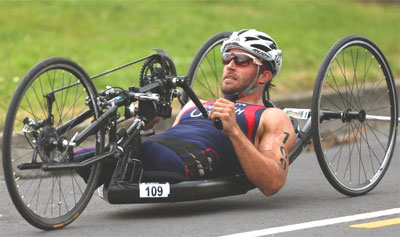 About 10 months after the accident, he decided he was going to "push forward and do whatever I could to have a fulfilling life." In 2008, he bought a racing wheelchair. In 2010, he participated in his first triathlon as a challenged athlete. He was hooked. Since then, he became the first challenged athlete to complete: - an Ultraman Triathlon (6.2-mile swim, 262-mile bike, 52-mile run)
- the Brazil 135 (a 135-mile foot race, which he did as a wheelchair athlete)
Kajlich is currently training to become the first solo hand cyclist to complete the Race Across America, which is more than 3000 miles. Colin O'Brady: A Solo Trek Across Antarctica Crossing Antarctica has been a human endurance goal for 100 years. Attempts have been made by Brits Robert Scott and Ernest Shackleton and by Norwegian Roald Amundsen in the early 1900's. In 1996-1997, Borge Ousland (Norway) completed an incredible 1,864-mile, 2-month crossing. He started and ended where open water met the Antarctic ice shelf. But, he also used a ski-sail in part of this crossing. Could it be done using only human power? Henry Worsley died while trying this. Shortly thereafter, explorer Ben Saunders made an attempt and failed. In late 2018, American triathlete Colin O'Brady (Portland, OR) set out from the Messner Start on November 3, 2018. Separately, British Army captain Louis Rudd (UK) was attempting the same challenge. He started on the same day, though several miles away. O'Brady (age 33) was on cross-country skis and was pulling a 375-pound sled. O'Brady had named this quest "The Impossible First" and it seemed that this description might be accurate: Day 1 was so hard he only managed 2 miles. He dumped a lot of his food to lighten his load, despite anticipating requiring about 7000 calories a day during this trip. Keep in mind that his goal was to do the entire distance completely unassisted: no food drops along the way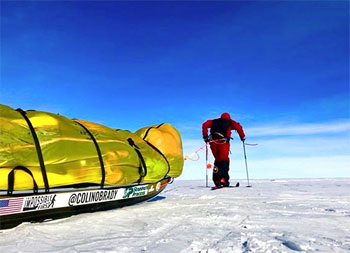 On Day 40, O'Brady reached the South Pole, climbing from sea level to 9301-feet elevation. He was ahead of Louis Rudd. But it had been a brutal trek so far. The weather wasn't cooperating: Lots of snow meant trudging through soft powder...much more difficult than gliding across the top of a hard, ice-crusted surface. Windchill dropped to as low as -80 degrees. He had covered 570 miles and had another 360 miles to go. O'Brady reduced his caloric intake to 6100 calories per day. But, he was losing a lot of weight. On Day 53, he was running out of food and was still 77 miles from the finish. O'Brady decided to cover those final 77 miles in one non-stop session. It took him 32 hours but he made it. On December 26, 2018 he reached the Leverett Glacier at the edge of the Ross Ice Shelf, becoming the first person to complete a solo traverse of Antarctica unaided. He had hiked/skied 930 miles in 54 days. He finished with only 1 days' supply of food left. But there's another detail to point out: At age 22, in Thailand, O'Brady was watching a ceremony where fire dancers were jumping a flaming rope. O'Brady decided to join in. But, the rope tangled around his legs, burning about 25 percent of his body. Physicians cautioned him that he might never walk again! Karl Bushby: The Longest Walk Ever Attempted? If ultradistance running seems a little crazy, wait till you read about this walking odyssey: On November 1, 1998, Karl Bushby (UK) (age 29), a former British paratrooper, set out from Punta Arenas, Chile (southern tip of Chile) to walk home.....not really a big deal until you realize his hometown is Hull in Northern England. Total distance: 36,000 miles! Preposterous? Yes. Impossible? Maybe not. Don't underestimate this guy. He has already walked the entire length of South America, Central America, and North America, though this has taken 13 years. He even crossed the Bering Strait under his own power. Where there was ice, he walked. Where there wasn't, he swam to the next big chunk....while hauling a 400-lb sled behind him. It took him 13 days to cover the 58 miles that separates Alaska and Russia. When he started out (from Chile) in 1998, Bushby had a laptop, a satellite phone, a solar-powered charger, and 800 dollars in his pocket. He bought a used pushcart which helped on rough roads. He initially planned to walk 20 miles per day, but the pushcart fell apart on the first day, and he lost his toenails after a week. In 2001, he reached the most dangerous part of the trip: the Darien Gap in Colombia, a jungle filled with jaguars, snakes, and armed revolutionaries. Here, he dyed his hair black and disguised himself as a Colombian drifter. At one point, he hid under a mat of branches and floated in the crocodile-infested Rio Atrato for 4 days with boats of soldiers passing just feet from his head. Once into Mexico, he obtained another pushcart and made it to the US border in 2002, only to encounter the 120-degree heat of the Mojave Desert. He followed the Rockies up into Montana. Close to the US-Canadian border, he went into a bar to celebrate the New Year. While inside, his push-cart was stolen. He lost all his gear, his passport, his maps, and all his notes up to that point. In the fall of 2003, he was in Fairbanks, Alaska. Here, he traded in his pushcart for a sled. After 6 years of heading north, he was now pointed towards the west. Nature, and 17,000 miles of walking, couldn't stop him, but the Russian government did. Just hours after reaching land (after crossing the Bering Strait), Russian authorities apprehended him and detained him for 58 days. In addition, their visa stipulates that he can be inside the country for no more than 90 consecutive days. Then, he must leave for 90 days. This might be acceptable, except for the fact that the tundra in Chukotka is swamp and, thus, can only be walked upon when it is frozen. In March 2013, Russia banned Bushby from re-entering Russia for 5 years. So, he walked from Los Angeles to the Russian Embassy in Washington DC to convince the Russian government to let him resume his walk where they stopped him. In 2014, they granted him a new Visa. In 2017, Bushby crossed the Russia-Mongolia border. On August 8, 2018, he was in Mongolia. In June 2019, he crossed into Uzbekistan. Unfortunately, due to the coronavirus pandemic, his quest has been sidelined again. At the time of this writing (September 2020), he is waiting to resume his "Goliath Expedition." He is now 51 yrs old and has been pursuing this dream for 22 years. Jason Lewis: Circle the Globe Using Only Human Power On July 12, 1994, Jason Lewis (UK) set out to circle the globe using only human power. For this feat to be "official," several conditions had to be met: - only human power can be used: bicycles, row-boats, kayaks, skates are all acceptable, but no motors and no sails
- the Equator must be crossed
- two antipodal points must be visited: this means that, if you stuck a spear through the exact center of the earth, the entry point and the exit point at the surface would be "antipodal" points
Jason Lewis did it. On October 6, 2007 -- after 13 years and over 45,000 miles! -- he arrived back in the UK. If the sheer distance involved isn't mind-boggling enough, stop and think how one would cross the oceans without a motor or a sail. So, how did he do that? He used a pedal-powered boat. No kidding. You can read more about his adventure at: www.Expedition360.com. FEATS OF STRENGTH Some feats of strength are amazing, too: • Bench Press: In November 2004, Gene Rychlak, Jr. (Royersford, PA) became the first person to bench-press 1000 lbs! 1004 lbs, to be exact. Believe it or not, 5 guys have now benched more than 1000 lbs. The current world record is an inconceivable 1105 lbs, by Will Barotti (New York) in June 2020. • Dead Lift: In May 2020, Hafthor Bjornsson (Reykjavik, Iceland) dead-lifted 1104 lbs! This guy is 6'9" and weighs 450 lbs. No wonder they call him "The Mountain." • Pull-Ups: The greatest number of pull-ups performed in succession was 91 by a Marine recruit (source: Men's Health magazine, 2008). The record-holder for greatest number of pull-ups in a 24-hr period is David Goggins (Buffalo, NY): On January 20, 2013, in Brentwood, TN, Goggins completed 4030 pull-ups in 17 hours! It was his third attempt to break the record. On November 27, 2012, he completed 3207 pull-ups in 12 hours, but had to stop due to an injury on his right palm. OK, SO CHALLENGE ME! So, now, you feel like testing yourself, eh? Well, here ya' go: Ultra-Marathons • World's Oldest and Largest Foot Race (56 miles): The "Comrades Marathon" in South Africa is actually a 90 km (55.9 miles) ultramarathon. It originated in 1921. One year it is run "up" starting in Durban, and the alternating year it is run "down" from Pietermaritzburg. Athletes have 12 hours to complete the course. Also, there are a number of cut-off points along the route that runners must reach by a predetermined time or else be forced to retire from the race. For more information, go to: www.Comrades.com. • An Ultramarathon at High-Altitude (100 miles): The "Leadville Trail 100" is an ultramarathon held annually on trails near Leadville, Colorado. The course is 50 miles out and back, starting at 10,200-ft elevation. At its highest point, the course crosses Hope Pass at 12,620-ft. This race was first run in 1983. It is common for less than half the competitors to complete the course in the required 30-hr time limit. For more information, go to: www.LeadvilleRaceSeries.com. • World's Hottest Foot Race (135 miles): How about running 5 marathons in a row? And, while you're at it, turn up the heat, a little? The "Badwater Ultramarathon" is a 135-mile race from Death Valley to Mt. Whitney....during July! Temperatures can exceed 120 degrees. Think this is crazy? Well, yes, it is, though, this race has been held annually since 1977. (Pam Reed won it in 2002, and Dean Karnazes won it in 2004.) If you want to compete in what is billed as the "world's toughest foot race," go to: www.Badwater.com. • World's "Most Grueling" Foot Race (155 miles): The "Spartathlon" in Greece describes itself as the "most grueling" distance run. This a footrace from Athens to Sparta.....the distance is 250 km, or 155 miles. It was first organized in 1983 to mimic the course Pheidippides covered when ordered to run to Sparta to obtain military reinforcements for the battle of Marathon in 490 BC. According to legend, Pheidippides completed the Athens-to-Sparta distance in 2 days. If you're interested in reliving ancient history, here is the web site: www.Spartathlon.gr. • World's Longest Foot Race (3100 miles): The longest certified road race in the world (not counting relays) is called the "Self-Transcendence Race" held annually in Queens, NY. Competitors attempt to run 5649 laps of a 0.549-mile course within 52 days. That works out to 3100 miles total, or, about 60 miles each day (source: Runner's World magazine, Nov. 2006). For more info, go to: Sri Chinmoy's web site • A Marathon at Even Higher Altitude: The "Everest Marathon" is listed in the Guinness Book of World Records as the highest marathon in the world. The starting line is at 17,000-ft elevation! The finish line is at the Sherpa town of Namche Bazaar (11,300-ft elevation). The course is 26.2 miles and consists of rough mountain trails. It was first held in 1987. For more information, go to: www.EverestMarathon.org.uk. Cycling Does a 3000-mile bicycle race interest you? If so, then the "Race Across America" is what you're looking for. This race has been held annually since 1982. It starts in Oceanside, CA and finishes in Annapolis, MD. The route goes through 14 states, and includes over 100,000 feet of climbing. The race can be done as a solo rider, or, as a team. Typically, solo racers finish in 9-12 days, averaging 250-350 miles per day. Teams have a relay format and race 24 hours per day. For details, see: Race Across America Crazy Athletic Challenges Looking for even more difficult challenges? Consider these: • Racing The Planet: This involves running through 4 deserts: the Atacama Crossing (Chile), the Gobi Desert (China), the Sahara Desert (Egypt), and, finally Antarctica (it's a frozen desert). Each race is 250-km (150 miles) divided over 6 days. Yes, Dean Karnazes has done this event, too, but, of course, he had to put his own spin on it so he added in the Badwater Ultramarathon in Death Valley. In November 2016, Jax Mariash Koudele, an endurance runner from Wyoming, became the first woman to complete the 4 Deserts Grand Slam Plus. If you're interested, the web site is: www.RacingThePlanet.com. • Explorers Grand Slam: The goal here is to reach the North Pole, the South Pole, and scale the highest peaks on all 7 continents in as short a period of time as possible. Guess who holds the record? Antarctica King Colin O'Brady. He accomplished this feat over a span of 139 days in early 2016. For more info, see: www.ExplorersGrandSlam.com WARNING: Before you try to find what your body can endure, keep in mind that anyone -- including elite athletes -- can overdo it. Any abrupt increase in exercise, particularly if the new activity is something that you are not used to, can put you at risk for a very serious medical condition known as "rhabdomyolysis." If you do something extreme, and develop extreme muscle pain and notice that your urine is looking like Coca-Cola, you need to seek medical attention immediately. To read more on this, go to: "Exertional Rhabdomyolysis." FOR MORE INFORMATION If you want to know who's currently trying to run across America, check out the web site "USA Crossers." (www.USACrossers.com). Readers may also be interested in these stories: EXPERT HEALTH and FITNESS COACHING Stan Reents, PharmD, is available to speak on this and many other exercise-related topics. (Here is a downloadable recording of one of his Health Talks.) He also provides a one-on-one Health Coaching Service. Contact him through the Contact Us page. REFERENCES The details provided in this story were obtained from Men's Health magazine, National Geographic's Adventure magazine, Runner's World magazine and the various web sites cited above. ABOUT THE AUTHOR 
Stan Reents, PharmD, is a former healthcare professional. He has been a member of the American College of Lifestyle Medicine (ACLM) and a member of the American College of Sports Medicine (ACSM). In the past, he has been certified as a Health Fitness Specialist by ACSM, as a Certified Health Coach by ACE, as a Personal Trainer by ACE, and as a tennis coach by USTA. He is the author of Sport and Exercise Pharmacology (published by Human Kinetics) and has written for Runner's World magazine, Senior Softball USA, Training and Conditioning and other fitness publications.
Browse By Topic:
adventure races, exercise motivation, extreme exercise, health and fitness targets, running, ultra-endurance races
Copyright ©2025 AthleteInMe,
LLC. All rights reserved.
|